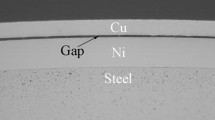Abstract
Microcasting based on the investment casting process is a suitable method to shape various metals. It has mostly been used for parts in the millimeter and centimeter range made of precious alloys. A newly developed plaster-bonded investment allows to manufacture small structures in the micrometer range made of base alloys such as Al bronze. Compared to phosphate-bonded investments, the plaster-bonded investment can be easily removed from cast parts with very complicated microstructures without damaging or influencing the chemically reactive metal. Additionally, it was found that the new plaster-bonded investment significantly improves the casting of the gold base alloy Stabilor® G, because the mold filling ability for structures in the submillimeter range was greatly facilitated at an even lower preheating temperature of the mold.





Similar content being viewed by others
References
al-Mesmar HS, Morgano SM, Mark LE (1999) Investigations of the effect of three sprue designs on the porosity and the completeness of titanium cast removable partial denture frameworks. J Prosthet Dent 82(1):15–21
Bach Fr-W, Moehwald K, Hollaender U, Nakhosteen B (2001) Entwicklung einer neuen Metallgießtechnik für die Mikromechanik. Z Metallkd 92(3):207–211
Battaini P (2004) Investment casting for oral cavity applications: peculiarities and problems. La Metallurgia Italiana 10:57–69
Baumeister G, Ruprecht R, Hausselt J (2004) Replication of LIGA structures using microcasting. Microsyst Technol 10(6–7):484–488
Brockhurst PJ, McLaverty VG (1983) Chemical analysis, castability and tensile properties of twenty-one dental base metal casting alloys for removable dental appliances. Aust Dent J 28(6):370–377
Coghill TL (1983) Investment casting offers economy for many applications. Precis Met 41(3):23–26
DIN EN (1982) Issue 1998-12, Beuth-Verlag, Berlin
Hunt LB (1980) The long history of lost wax casting, Gold bulletin no. 13, pp 63–79
Jones S, Yuan C (2003) Advances in shell moulding for investment casting. J Materials Processing Technol 135(2–3):258–265
Kempf B (1996) Dentalwerkstoffe in: Enzyklopädie Naturwissenschaft und Technik, 2. Auflage, ecomed, Landsberg
Kempf B, Hausselt J (1992) Gold, its alloys and their uses in dentistry. Interdisciplinary Sci Rev 17(3):251–260
McCloskey JC (1987) The application of commercial investment casting principles to jewelry casting. In: The Santa Fe symposium on jewelry manufacturing technology, Santa Fe, New Mexico, USA, 17–19 September 1987, (1988), pp 203–222
McCloskey JC, Aithal S, Welch PR (2001) Silicon microsegregation in 14K yellow gold jewelry alloys. Gold Bull 34(1):3–13
McKeown J (1997) Investment casting: a manufacturing alternative. Metal Casting Finishing (Aust) 43(1–2):42–45
Moehwald K, Morsbach C, Bach Fr-W, Gatzen H-H (1999) In: Investigations on capillary action microcasting of metals, 1st international conference and general meeting of the European society for precision engineering and nanotechnology, vol 1. Shaker Verlag, Bremen, pp 490–493
Ott D (1988) Methods for investment casting in the jewelry industry: principles, advantages, disadvantages. In: The Santa Fe symposium on jewelry manufacturing technology 1988, Santa Fe, 21–24 September 1988, (1989), pp 203–216
Power DC (1995) Palladium alloy pinning wires for gas turbine blade investment casting. Platinum Metals Rev (UK) 39(3):117–126
Rashid A, Campbell J (2004) Oxide defects in a vacuum investment-cast Ni-based turbine blade. Metall Materials Trans A 35(7):2063–2071
Raub Ch (1981) The lost wax procedure for casting jewellery—part I. Metallurgia 35(12):1257–1259
Sangle VS (2001) Investment casting, Institute of Indian Foundrymen. Indian Foundry J (India) 47(8):23–28
Smart RF (1985) Fifty years of investment casting. Metallurgia 52(11):458–459
Smart RF (1993) Investment casting. Cookson Tech Bull Fourth Q 4(4):3–5
Valerio F (2003) Handbook of investment casting. World gold council, London
Acknowledgements
Financial support by the Deutsche Forschungsgemeinschaft under the Sonderforschungsbereich (Collaborative Research Center) 499 in cooperation with the Technical University of Karlsruhe, Germany, is gratefully acknowledged. Additionally, we would like to thank Degussa Dental for providing the precious alloys.
Author information
Authors and Affiliations
Corresponding author
Rights and permissions
About this article
Cite this article
Baumeister, G., Rath, S. & Hausselt, J. Microcasting of Al bronze and a gold base alloy improved by plaster-bonded investment. Microsyst Technol 12, 773–777 (2006). https://doi.org/10.1007/s00542-006-0105-3
Received:
Accepted:
Published:
Issue Date:
DOI: https://doi.org/10.1007/s00542-006-0105-3




